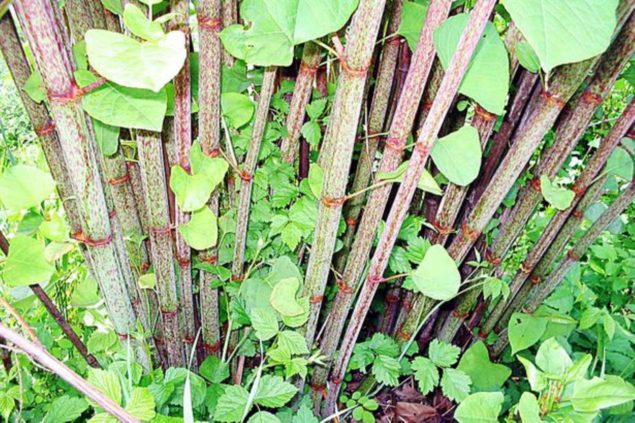It is a robust bamboo-like perennial that spreads through long creeping rhizomes to form dense bushes. Polygonum cuspidatum, or Japanese knotweed, was initially imported as an ornamental plant and is native to Japan and other parts of Asia. Although itadori knotweed is edible and valuable in its native place, in North America, the species is not restricted by local insects or competitive vegetation. It can thrive and spread in various conditions, mainly along riverbanks, roadsides, and other wet and disturbed areas. Containing and controlling all invasive knots is a great challenge, but it is essential to protect uninfected sites from damage caused by such plants.
Japanese Knotweed Identification
Identification of Polygonum cuspidatum or Japanese knotweed is not always easy; If you ignore the potential intrusion, it can have destructive and costly legal consequences. The best time to discover Japanese herbs is in midsummer and early fall. In the spring, red / violet branches grow out of the ground, and plump asparagus-like “spears” quickly grow out of the bright pink “crown” buds. They can grow up to 2 cm per day, quickly forming dense bamboo-like stems and growing heart-shaped or shield-shaped green leaves. In early summer, the mature stalks of Japanese knots are hollow, with purple spots up to 3 meters high. The leaves alternate along each side of the stem, producing distinct jagged knots. Japanese knots can grow in different shapes and forms according to the season, previous treatment methods, and surrounding environment.
Bonsai growth is entirely different from average growth, making Japanese knot recognition a challenging prospect that requires a well-trained eye.
Japanese Knotweed Benefits
Polygonum cuspidatum is used to treat bronchitis, cough, gum disease (gingivitis), and mouth and throat pain. It is also used to treat lung diseases, skin conditions, and fluid retention. Some people use it to reduce sweating and stop the bleeding associated with tuberculosis. Polygonum cuspidatum can reduce swelling. It also averts plaque from developing on your teeth.
Uses and efficacy
- Gum disease (gingivitis). Development research indicates that Polygonum cuspidatum root extract can be used as a mouthwash to treat gingivitis. Gingivitis is caused by dental plaque, a layer of saliva and bacteria that accumulate on the teeth on the gum line. Polygonum cuspidatum extract seems to reduce gum bleeding and swelling, possibly because it interferes with the formation of dental plaque.
- Bronchitis.
- Cough.
- Lung disease.
- Skin disease.
- The liquid is stranded.
- Reduces sweating related to tuberculosis.
- Stop bleeding.
- Other conditions.
Japanese Knotweed Removal
Japanese knotweed Weed is one of the most invasive plants in the world. You can find knotweed in the garden and usually in public areas. As we all know, it has grown through the foundation of the building and taken over the landscape. This can seriously affect the property value because if mortgage lenders know that Japanese knotweed exists on properties nearby or in certain areas, they will refuse, so they know where to avoid it.
You can take many methods to kill Polygonum cuspidatum(Japanese knotweed) but this invasive plant may require multiple attacks to control.
- Kill it with a herbicide
- Choke him with a tarp
- Dig up the rhizome
- Cut to the ground
- Professional moving service
Japanese Knotweed Treatment
Japanese knotweed (Polygonum cuspidatum) is a tall perennial herb, commonly known as “bamboo.” It grows in dense patches, up to 10 feet in height, and is distributed in various locations from mine fragments to gloomy streams. It is native to Asia and was first introduced to the United States as an ornamental plant in the late 1800s. Among the CREP plantations, knotweeds will invade the riparian buffer forest plantations and grassland areas. Polygonum cuspidatum provides a small habitat value that, in addition to covering, dramatically reduces the weight of wildlife habitat on its farm.
Knotweed Control Measures
Knotweed control must control the rhizome system. To prevent Polygonum cuspidatum infection at a controllable level, you must start with multiple treatments, which take at least two years. The numerous treatment methods are based on the depletion of stocks stored in rhizomes in late spring and the damage caused by the use of systemic herbicides in late summer.
The herbicide glyphosate in late summer is one of the most effective treatment methods. At the end of the growing season, the crown will distribute the sugar in photosynthesis to the rhizome for storage. Glyphosate and these sugars pass through the plant to the rhizome. It also has the advantage of having no activity on the ground. This reduces the risk of damage to non-target plants through root uptake, especially when planting riparian forest buffers. If glyphosate touches the leaves of non-target plants, they can be injured or killed.



